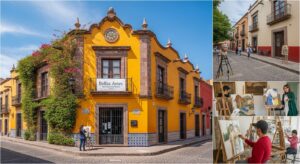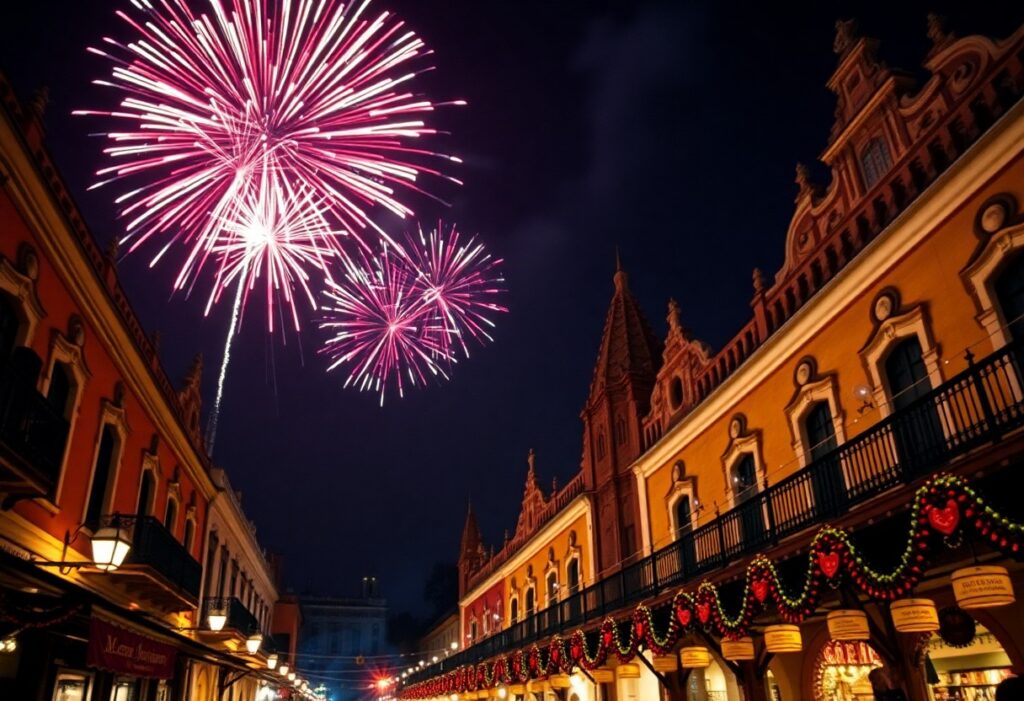The Allure of Bellas Artes
Wandering through Bellas Artes feels like stepping into a living canvas of artistic expression. The school’s magnetic charm draws you into its meticulously preserved colonial spaces, where creativity flows as freely as the sunlight filtering through ancient arches. With over 30 different art classes offered annually, you’ll find yourself surrounded by passionate artists from around the world, each exploring their craft in studios that breathe with historical significance. Every corner tells a story, from the student murals adorning the walls to the whispers of artistic legends like Siqueiros who once walked these hallowed halls.
Key Takeaways:
- Bellas Artes is a historic art school located in a transformed 18th-century convent in San Miguel de Allende, offering diverse arts programming including classes in drawing, painting, ceramics, photography, music, and dance.
- The school is named after Ignacio Ramírez, a famous Mexican intellectual and atheist, and features a notable unfinished mural by renowned Mexican artist David Alfaro Siqueiros, adding to its rich cultural significance.
- Situated just two blocks from the Jardín, Bellas Artes serves as a peaceful cultural oasis with a stunning landscaped cloister, café, galleries, and performance spaces that attract both local and international artists and students.
Transformative History of a Sacred Space
The journey of Bellas Artes from a religious sanctuary to a vibrant cultural center represents a remarkable transformation of sacred space. Each stone and archway tells a story of reinvention, preserving the building’s spiritual essence while embracing artistic expression. The walls that once echoed with monastic prayers now resonate with creative energy and cultural exploration.
The Convent Origins
Constructed between 1755 and 1765, the original convent belonged to the Immaculate Conception order, founded by María Josefa Lina de la Canal y Hervás. Nestled in the heart of San Miguel, this architectural gem served as a place of contemplation and religious devotion for generations of nuns, its elegant design reflecting the spiritual commitment of its inhabitants.
The Evolution into an Art Institute
In 1937, Felipe Cossío del Pomar sparked a revolutionary vision by requesting government permission to establish an art school. Stirling Dickinson became the first director, transforming the former convent into a haven for creative expression. The space began its metamorphosis from a religious sanctuary to a dynamic cultural center, welcoming artists and students from around the world.
The transformation of Bellas Artes was more than a physical renovation. When President Benito Juárez’s secular reforms in the 1860s repurposed church properties, the building had already experienced multiple incarnations—serving as an elementary school, housing cavalry during the Revolution, and eventually becoming a national cultural institute. Artists like David Alfaro Siqueiros would later teach here, further cementing its reputation as a pivotal artistic space. The school’s evolution mirrored Mexico’s own cultural renaissance, turning a once-cloistered environment into an open, inspiring platform for artistic exploration and education.
A Garden Oasis Amidst City Hustle
Stepping into Bellas Artes transports you from San Miguel’s vibrant streets into a serene sanctuary of art and nature. The moment you pass through its historic archways, the city’s noise fades, replaced by gentle fountain sounds and artistic whispers. This transformed convent space offers a tranquil retreat that seamlessly blends architectural heritage with creative energy, making it more than just an art school—it’s a living, breathing cultural haven.
The Architectural Beauty
The building’s colonial architecture speaks volumes of San Miguel’s rich history. Elegant stone arches, meticulously preserved walls, and original 18th-century structural elements create a breathtaking backdrop for artistic expression. Sunlight filters through historic windows, casting intricate shadows on floors that have witnessed centuries of transformation from religious sanctuary to creative sanctuary.
Nature’s Embrace: Landscaping at Bellas Artes
Lush greenery transforms the school’s courtyard into a botanical masterpiece. Twenty-foot bamboo plants tower overhead, while vibrant poinsettias and carefully curated tropical plants create a living canvas. The central fountain, crowned with its symbolic Lamb of God, provides a meditative focal point amidst the verdant landscape.
The landscaping at Bellas Artes is a deliberate artistic statement, carefully designed to complement the school’s creative mission. Native Mexican plants like orange trees, rubber trees, and exotic ferns create microclimates that support diverse flora. Strategic plantings provide natural cooling, shade art studios, and create acoustic buffers that enhance the peaceful atmosphere. Each plant is positioned to frame architectural elements, turning the entire courtyard into a dynamic, living artwork that changes with seasons and light, inviting artists and visitors to experience nature’s own creative process.
The Artistic Legacy of Ignacio Ramírez
Ignacio Ramírez emerged as a transformative intellectual force in 19th-century Mexico, challenging societal norms through his radical thinking and prolific writing. His multifaceted career spanned law, politics, literature, and social reform, making him a pivotal figure in Mexican cultural development. Ramírez’s intellectual prowess and fearless critique of established institutions positioned him as a key architect of progressive thought during a tumultuous period of Mexican history.

Celebrating an Atheist Icon
Ramírez boldly challenged religious orthodoxy with his provocative statement, “God Does Not Exist: The Beings of Nature Maintain Themselves”. This declaration marked him as a revolutionary thinker, earning him the nickname “El Nigromante” and solidifying his reputation as Mexico’s most prominent atheist intellectual. His fearless approach to challenging religious dogma set him apart as a radical voice of enlightenment.
Ramírez’s Impact on Mexican Culture
As a multidisciplinary intellectual, Ramírez influenced Mexican cultural and political discourse through his writings on history, politics, science, and literature. His work challenged existing power structures and promoted progressive ideas that would shape national identity and intellectual thought for generations to come.
Ramírez’s profound impact extended far beyond his initial provocations. He served as a Supreme Court justice, contributed to significant political reforms, and wrote extensively across multiple disciplines. His intellectual legacy influenced key movements in Mexican education, political philosophy, and cultural development. Scholars consider him a critical bridge between colonial thinking and modern Mexican intellectual traditions. Ramírez challenged religious and political orthodoxies, promoted secular education, and advocated for social progress through his writings and political activism. His work laid groundwork for future reformers and intellectuals, making him a pivotal figure in Mexico’s journey toward modernization and intellectual freedom.
Unfinished Masterpieces: The Siqueiros Mural
A Look at Siqueiros’ Uncompleted Work
Nestled along the north wall of the cloister, Siqueiros’ unfinished mural stands as a powerful testament to artistic passion. Created during his 1949 teaching stint at Bellas Artes, the mural captures the raw energy of Mexican muralism. Despite being incomplete, the artwork radiates an intense visual narrative, with vibrant colors and bold abstract forms that draw you into its unfinished complexity.
Legacy and Influence in Muralism
Siqueiros’ brief but impactful presence at Bellas Artes left an indelible mark on Mexican art. His volatile temperament and artistic brilliance created a moment of tension that would become legendary in San Miguel’s art history. The unfinished mural symbolizes the unpredictable nature of creative genius, frozen in time within the walls of this historic art school.
Legacy and Influence in Muralism
David Alfaro Siqueiros revolutionized Mexican muralism through his innovative techniques and political commitment. As part of the famous Mexican muralist trio alongside Diego Rivera and José Clemente Orozco, he transformed public art into a powerful medium of social commentary. His experimental approach to painting, including the use of industrial materials and unconventional tools, challenged traditional artistic methods. At Bellas Artes, Siqueiros mentored a generation of post-World War II artists, many of whom were U.S. veterans seeking creative expression. His technical innovations and political passion continued to inspire artists worldwide, making him a pivotal figure in 20th-century art movements that extended far beyond Mexico’s borders.
The Dynamic Hub of Creativity
Nestled within the historic walls of the former convent, Bellas Artes pulses with artistic energy. The center transforms traditional spaces into vibrant workshops and studios, attracting local and international artists who seek inspiration in San Miguel’s unique creative atmosphere. Its reputation extends far beyond local boundaries, drawing creative souls from around the world to explore and develop their artistic potential.
Diverse Classes and Workshops
You’ll discover an impressive range of artistic disciplines at Bellas Artes, from traditional painting and ceramics to contemporary photography and digital arts. Students can immerse themselves in week-long intensive courses or join ongoing weekly classes, with experienced instructors guiding participants through techniques that range from classical Mexican art traditions to cutting-edge contemporary practices.
Cultural Events and Community Engagement
Bellas Artes serves as a dynamic cultural nexus for San Miguel, hosting exhibitions, performances, and community events that celebrate artistic expression. The center’s programming bridges local traditions with international artistic dialogues, creating a platform where creativity flourishes and cultural exchange becomes a lived experience.
The center’s community engagement extends well beyond traditional classroom settings. Throughout the year, Bellas Artes orchestrates multiple festivals, artist talks, and collaborative projects that connect local and international artists. During events like the San Miguel International Jazz Festival and the Cervantino Festival, the center becomes a vibrant hub where musicians, visual artists, performers, and art enthusiasts converge. Student exhibitions, workshops with visiting international artists, and collaborative community art projects demonstrate the institution’s commitment to nurturing creativity and fostering cross-cultural understanding through artistic expression.
Final Thoughts
San Miguel’s Bellas Artes transcends the typical art school experience, weaving historical significance with contemporary creativity. Nestled in a transformed convent, this cultural hub represents more than just artistic education—it embodies the vibrant spirit of Mexican artistic heritage. From Siqueiros’ unfinished mural to the lush courtyard gardens, every corner tells a story of cultural transformation, intellectual rebellion, and artistic passion. Visiting Bellas Artes isn’t just recommended, it’s important for understanding the soul of San Miguel de Allende’s rich artistic landscape.
FAQ
What is the historical background of Bellas Artes in San Miguel de Allende?
Bellas Artes was originally constructed between 1755-65 as the cloister of the Convent of the Immaculate Conception (Las Monjas). Founded by María Josefa Lina de la Canal y Hervás, the building transformed from a religious space to an art school in the 1960s. It is now associated with Mexico’s Instituto Nacionál de Bellas Artes (INBA) and named after Ignacio Ramírez, a famous local atheist and intellectual.
What types of artistic activities are offered at Bellas Artes?
Bellas Artes offers a diverse range of artistic classes and activities, including drawing, painting, ceramics, weaving, photography, printmaking, music, and dance. The center features gallery exhibitions, a concert hall, and multiple studio spaces. Visitors can also enjoy the Café Las Musas, located under the cloister arcades, while experiencing the beautiful landscaped garden.
Who was David Alfaro Siqueiros, and what is his connection to Bellas Artes?
David Alfaro Siqueiros was a renowned Mexican muralist who taught at Bellas Artes in 1949. He is famous for an unfinished but powerful mural located in the former nuns’ refectory. Known for his volatile temperament, Siqueiros reportedly left the mural incomplete after a disagreement with school administrators. The mural remains a significant artistic attraction at the center, recently restored to showcase its original vibrant colors.





I love how you described Bellas Artes as a “living canvas”—what a perfect metaphor! I still chuckle at my own attempts in an art class there; if artistic expression were a sport, I might have earned a medal for “Most Likely to Confuse Finger Painting with Modern Sculpture.” But that’s the magic of places like Bellas Artes! They embrace every level of talent, from the da Vinci wannabes to those of us who just can’t quite figure out the difference between watercolor and wall paint.
The rich narrative you’ve woven around Bellas Artes beautifully encapsulates the essence of what makes this place so captivating. Your description of the school as a living canvas of artistic expression resonates deeply, especially considering how art schools like Bellas Artes play a vital role in fostering creativity and community among artists. The historical context of its location in a transformed 18th-century convent adds an intriguing layer to the experience, highlighting the importance of space in nurturing artistic pursuits.
You’ve really captured what makes Bellas Artes special. The way so many artists interact with that space is fascinating. It’s like every corner of the school tells a different story. You walk through those halls and feel the history, right? The old convent architecture gives it an almost sacred vibe, which seems to encourage creativity in a way that’s hard to put into words.
“Discover more about the enchanting history and vibrant artistic community of Bellas Artes here!”
https://fallinginlovewithsanmiguel.com/transport
Bellas Artes serves as a remarkable testament to the intersection of history and innovation in the arts. This blend not only nurtures individual creativity but also fosters a sense of community among artists from diverse backgrounds. The emphasis on various disciplines—from visual arts to music and dance—certainly reflects a holistic approach to creative education.